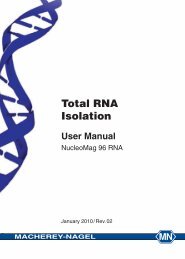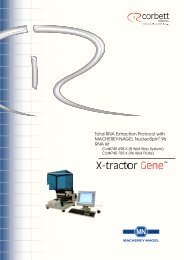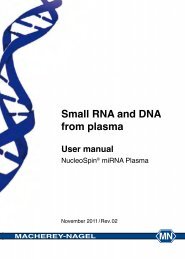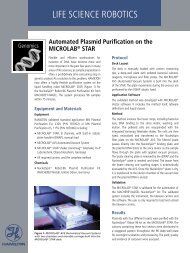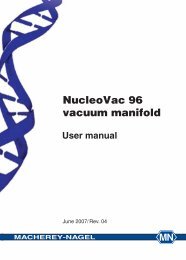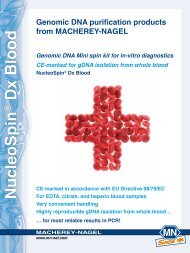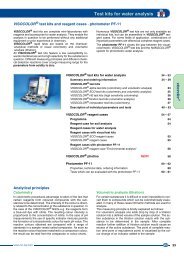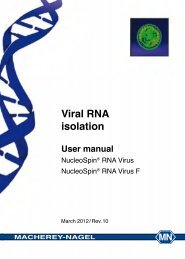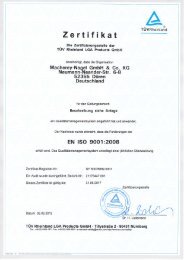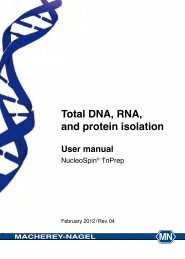PCR clean-up Gel extraction - Macherey Nagel
PCR clean-up Gel extraction - Macherey Nagel
PCR clean-up Gel extraction - Macherey Nagel
Create successful ePaper yourself
Turn your PDF publications into a flip-book with our unique Google optimized e-Paper software.
<strong>PCR</strong> <strong>clean</strong>-<strong>up</strong><br />
<strong>Gel</strong> <strong>extraction</strong><br />
User manual<br />
NucleoSpin ® <strong>Gel</strong> and <strong>PCR</strong> Clean-<strong>up</strong><br />
January 2012 / Rev. 02
<strong>PCR</strong> <strong>clean</strong>-<strong>up</strong>, gel <strong>extraction</strong><br />
Protocol-at-a-glance (Rev. 02)<br />
1 <strong>PCR</strong> <strong>clean</strong>-<strong>up</strong>,<br />
DNA <strong>clean</strong>-<strong>up</strong>, or<br />
single stranded DNA<br />
<strong>clean</strong>-<strong>up</strong>:<br />
Adjust binding condition<br />
<strong>Gel</strong> <strong>extraction</strong>:<br />
Excise DNA fragment /<br />
solubilize gel slice<br />
2 Bind DNA<br />
<strong>PCR</strong><br />
<strong>clean</strong>-<strong>up</strong><br />
200 μL NTI/<br />
100 μL <strong>PCR</strong><br />
<strong>Gel</strong><br />
<strong>extraction</strong><br />
200 μL NTI/<br />
100 mg gel<br />
50 °C<br />
5–10 min<br />
11,000 x g<br />
30 s<br />
3 Wash silica membrane 700 μL NT3<br />
4 Dry silica membrane<br />
11,000 x g<br />
30 s<br />
DNA<br />
<strong>clean</strong>-<strong>up</strong><br />
(with SDS)<br />
500 μL NTB/<br />
100 μL sample<br />
Recommended:<br />
2 nd wash<br />
700 μL NT3<br />
11,000 x g<br />
30 s<br />
11,000 x g<br />
1 min<br />
5 Elute DNA 15–30 μL NE<br />
RT<br />
1 min<br />
11,000 x g<br />
1 min<br />
MACHEREY-NAGEL GmbH & Co. KG · Neumann-Neander-Str. 6–8 · 52355 Düren · Germany<br />
Tel.: +49 24 21 969-270 · Fax: +49 24 21 969-199 · tech-bio@mn-net.com · www.mn-net.com<br />
Single<br />
stranded<br />
DNA <strong>clean</strong>-<strong>up</strong><br />
200 μL NTC/<br />
100 μL sample
Table of contents<br />
<strong>PCR</strong> <strong>clean</strong>-<strong>up</strong>, gel <strong>extraction</strong><br />
1 Components 4<br />
1.1 Kit contents 4<br />
1.2 Reagents, consumables, and equipment to be s<strong>up</strong>plied by user 5<br />
1.3 About this user manual 5<br />
2 Product description 6<br />
2.1 The basic principle 6<br />
2.2 Kit specifications 6<br />
2.3 Removal of small DNA fragments and primer-dimers 8<br />
2.4 pH indicator 9<br />
2.5 Tips and tricks for <strong>extraction</strong>s from agarose gels 10<br />
2.6 DNA recovery depends on fragment size and elution volume 11<br />
2.7 Salt carry-over and low A 260 / A 230<br />
3 Storage conditions and preparation of working solutions 15<br />
4 Safety instructions 16<br />
4.1 Risk and safety phrases 16<br />
4.2 GHS classification 17<br />
5 Protocols 18<br />
5.1 <strong>PCR</strong> <strong>clean</strong>-<strong>up</strong> 18<br />
5.2 DNA <strong>extraction</strong> from agarose gels 20<br />
5.3 DNA <strong>extraction</strong> from polyacrylamide gels 22<br />
5.4 RNA <strong>extraction</strong> from agarose gels (Buffer NTC) 24<br />
5.5 DNA <strong>clean</strong>-<strong>up</strong> of samples containing SDS (Buffer NTB) 25<br />
5.6 Single stranded DNA <strong>clean</strong>-<strong>up</strong> (Buffer NTC) 26<br />
6 Appendix 27<br />
6.1 Troubleshooting 27<br />
6.2 Ordering information 30<br />
6.3 References 30<br />
6.4 Product use restriction / warranty 31<br />
MACHEREY-NAGEL – 01 / 2012, Rev. 02<br />
13<br />
3
1 Components<br />
1.1 Kit contents<br />
4<br />
<strong>PCR</strong> <strong>clean</strong>-<strong>up</strong>, gel <strong>extraction</strong><br />
NucleoSpin ® <strong>Gel</strong> and <strong>PCR</strong> Clean-<strong>up</strong><br />
10 preps 50 preps 250 preps<br />
REF 740609.10 740609.50 740609.250<br />
Binding Buffer NTI 10 mL 2 x 25 mL 2 x 120 mL<br />
Wash Buffer NT3<br />
(Concentrate)*<br />
6 mL 20 mL 2 x 50 mL<br />
Elution Buffer NE** 5 mL 15 mL 50 mL<br />
NucleoSpin ® <strong>Gel</strong> and <strong>PCR</strong><br />
Clean-<strong>up</strong> Columns (yellow<br />
rings)<br />
10 50 250<br />
Collection Tubes (2 mL) 10 50 250<br />
User manual 1 1 1<br />
* For preparation of working solutions and storage conditions see section 3.<br />
** Composition of Elution Buffer NE: 5 mM Tris/HCl, pH 8.5<br />
MACHEREY-NAGEL – 01 / 2012, Rev. 02
<strong>PCR</strong> <strong>clean</strong>-<strong>up</strong>, gel <strong>extraction</strong><br />
1.2 Reagents, consumables, and equipment to be s<strong>up</strong>plied<br />
by user<br />
Reagents<br />
• 96–100 % ethanol<br />
Consumables<br />
• 1.5 mL microcentrifuge tubes<br />
• Disposable pipette tips<br />
Equipment<br />
• Manual pipettors<br />
• Centrifuge for microcentrifuge tubes<br />
• Heating block, water bath, or thermomixer for gel <strong>extraction</strong><br />
• Scalpel to cut agarose gels<br />
• Vortex mixer<br />
• Personal protection equipment (lab coat, gloves, goggles)<br />
1.3 About this user manual<br />
It is strongly recommended reading the detailed protocol sections of this user manual<br />
if the NucleoSpin ® <strong>Gel</strong> and <strong>PCR</strong> Clean-<strong>up</strong> kit is used for the first time. Experienced<br />
users, however, may refer to the Protocol-at-a-glance instead. The Protocol-at-aglance<br />
is designed to be used only as a s<strong>up</strong>plemental tool for quick referencing while<br />
performing the purification procedure.<br />
All technical literature is available on the internet at www.mn-net.com.<br />
Please contact Technical Service regarding information about changes of the current<br />
user manual compared to previous revisions.<br />
MACHEREY-NAGEL – 01 / 2012, Rev. 02<br />
5
2 Product description<br />
2.1 The basic principle<br />
6<br />
<strong>PCR</strong> <strong>clean</strong>-<strong>up</strong>, gel <strong>extraction</strong><br />
NucleoSpin ® <strong>Gel</strong> and <strong>PCR</strong> Clean-<strong>up</strong> is developed as a 2-in-1 kit allowing DNA fragments<br />
to be purified from enzymatic reactions, such as <strong>PCR</strong>, as well as from agarose gels.<br />
The sample is mixed with Binding Buffer NTI and in case of a cut-out gel band, it is<br />
heated to dissolve the agarose. In the presence of chaotropic salt, the DNA is bound to<br />
the silica membrane of a NucleoSpin ® <strong>Gel</strong> and <strong>PCR</strong> Clean-<strong>up</strong> Column. Contaminations<br />
are removed by simple washing steps with ethanolic Wash Buffer NT3. Finally, the pure<br />
DNA is eluted under low salt conditions with slightly alkaline Elution Buffer NE (5 mM<br />
Tris/HCl, pH 8.5).<br />
2.2 Kit specifications<br />
• NucleoSpin ® <strong>Gel</strong> and <strong>PCR</strong> Clean-<strong>up</strong> is designed for fast purification of <strong>PCR</strong><br />
products, such as DNA from enzymatic reactions, as well as the <strong>extraction</strong> of<br />
DNA fragments from TAE or TBE agarose gels.<br />
• Only two volumes of binding buffer per volume of sample are needed to process<br />
<strong>up</strong> to 200 μL of <strong>PCR</strong> / enzymatic reaction, or 200 mg of agarose gel, with<br />
only one loading step. By adding additional Binding Buffer NTI (see ordering<br />
information) it is possible to load an unlimited amount of sample volumes onto<br />
a single column (tips and tricks in section 2.5).<br />
• Up to ~ 15 μg DNA from 50 bp to at least ~ 20 kbp can be purified efficiently<br />
in 10–20 min with average recoveries from ~ 60 to ~ 90 % depending on the<br />
fragment size and elution procedure (details in section 2.6).<br />
• The NucleoSpin ® <strong>Gel</strong> and <strong>PCR</strong> Clean-<strong>up</strong> buffer formulation ensures complete<br />
removal of all kinds of contaminations such as<br />
- nucleotides, primers<br />
- enzymes<br />
- mineral oil<br />
- <strong>PCR</strong> additives (e.g., salts, betaine, DMSO)<br />
- detergents (e.g., Tween 20, Triton X-100)<br />
- dyes (e.g., ethidiumbromide, crystal violet, Stain G, Midori Green, Roti ® -Safe<br />
<strong>Gel</strong>Stain, DNA SafeStain)<br />
- unbound labels and tags<br />
• Primers from <strong>PCR</strong> reactions are quantitatively eliminated while small DNA<br />
fragments are still bound and purified with high recovery (details in section 2.6).<br />
MACHEREY-NAGEL – 01 / 2012, Rev. 02
<strong>PCR</strong> <strong>clean</strong>-<strong>up</strong>, gel <strong>extraction</strong><br />
• The cut-off for small DNA fragments can be shifted from < 50 bp to several<br />
hundred bp by diluting Binding Buffer NTI to remove primer-dimers from target<br />
<strong>PCR</strong> products (details in section 2.3).<br />
• The pH-indicator in Binding Buffer NTI ensures optimal binding conditions with<br />
pH < 7.0 (details in section 2.4). The yellow color makes it easier to identify<br />
undissolved agarose during DNA gel <strong>extraction</strong>.<br />
• NucleoSpin ® <strong>Gel</strong> and <strong>PCR</strong> Clean-<strong>up</strong> can be used with all kinds of agarose<br />
gels (high or low melting) with 1 % to 5 % agarose and a variety of buffer<br />
systems like TAE or TBE (tips and tricks in section 2.5). The kit also works with<br />
low conductivity borate electrophoresis systems.<br />
• Concentrated elution in down to 10 μL Elution Buffer NE (details in section 2.6).<br />
• Several s<strong>up</strong>port protocols extend the application range of NucleoSpin ® <strong>Gel</strong><br />
and <strong>PCR</strong> Clean-<strong>up</strong> to<br />
- Clean-<strong>up</strong> of DNA from reaction mixtures containing SDS (section 5.5)<br />
- Clean-<strong>up</strong> of single stranded DNA (section 5.6)<br />
- Extraction of RNA from agarose gels (section 5.4)<br />
- Extraction of DNA from polyacrylamide gels (section 5.3)<br />
• The purified and concentrated DNA can directly be used for hybridization,<br />
sequencing, <strong>PCR</strong>, restriction, ligation, in vitro transcription, labeling or any<br />
other kind of enzymatic reaction.<br />
Table 1: Kit specifications at a glance<br />
Parameter NucleoSpin ® <strong>Gel</strong> and <strong>PCR</strong> Clean-<strong>up</strong><br />
Sample material Up to 200 μL of <strong>PCR</strong> reaction or 200 mg of gel<br />
(more sample with additional Binding Buffer NTI and<br />
multiple loading steps)<br />
Binding capacity 25 μg<br />
Fragment length 50 bp – ~ 20 kbp<br />
Elution volume 10–30 μL<br />
Optimal recovery < 15 μg, 100–500 bp, 30 μL<br />
Preparation time 10 min for 6 <strong>PCR</strong> purifications<br />
20 min for 6 gel <strong>extraction</strong>s<br />
MACHEREY-NAGEL – 01 / 2012, Rev. 02<br />
7
<strong>PCR</strong> <strong>clean</strong>-<strong>up</strong>, gel <strong>extraction</strong><br />
2.3 Removal of small DNA fragments and primer-dimers<br />
NucleoSpin ® <strong>Gel</strong> and <strong>PCR</strong> Clean-<strong>up</strong> is designed to remove even traces of unused<br />
primer while purifying <strong>PCR</strong> products down to 50 bp at the same time. However, in some<br />
cases it is necessary to exclude these small fragments. For example, primer dimers,<br />
or side products resulting from unspecific annealing, may interfere with downstream<br />
sequencing or cloning applications.<br />
Removal of double stranded DNA > 50 bp can be achieved by diluting an aliquot of<br />
Buffer NTI with sterile water in an appropriate ratio and then proceeding with the<br />
standard protocol (see section 5.1). Diluting Buffer NTI in a certain range lowers the<br />
binding efficiency for small fragments without compromising the recovery of larger <strong>PCR</strong><br />
products. However, the dilution ratio will highly depend on the fragment. Therefore, for<br />
each size of small fragments > 50 bp that has to be removed, as well as for each <strong>PCR</strong><br />
system, the appropriate ratio of Buffer NTI dilution can be determined in advance.<br />
Influence of fragment size: The smaller the fragment in question, the less you<br />
have to dilute Buffer NTI.<br />
Influence of <strong>PCR</strong> buffer system: The influence of the <strong>PCR</strong> buffer system on the<br />
removal of small fragments is more complex. Some reaction buffers contain detergents<br />
like Tween or high concentrations of additives like betaine to lower the melting<br />
temperature of the DNA template. These substances can usually be found in <strong>PCR</strong><br />
buffers for high fidelity or long range <strong>PCR</strong>. They tend to lower the binding efficiency<br />
of DNA to the silica membrane and therefore have to be considered when choosing<br />
a dilution ratio of Buffer NTI. As a rule of thumb, if a <strong>PCR</strong> buffer system without<br />
special additives is used, adding 3 to 5 volumes of water to 1 volume of Buffer<br />
NTI will lead to removal of small fragments <strong>up</strong> to 100 bp. Otherwise adding 1 to 3<br />
volumes of water to 1 volume of Buffer NTI will be sufficient.<br />
Therefore, for each size of small fragments > 50 bp that has to be removed, and for<br />
each <strong>PCR</strong> system, you can determine the appropriate ratio of Buffer NTI dilution, in<br />
advance.<br />
Figure 1 shows a purification result with a Buffer NTI dilution series. Pure Buffer NTI<br />
(lane 3), as well as Buffer NTI plus one volume of water (lane 4), lead to 100 % recovery<br />
of a <strong>PCR</strong> fragment ladder (lane 2). More diluted Buffer NTI cuts off more and more of<br />
the low molecular mass bands. Usually a dilution with 5 volumes of water should be<br />
sufficient to eliminate even larger unwanted primer-dimer fragments while purifying the<br />
164 bp fragment with > 90 %.<br />
8<br />
MACHEREY-NAGEL – 01 / 2012, Rev. 02
<strong>PCR</strong> <strong>clean</strong>-<strong>up</strong>, gel <strong>extraction</strong><br />
1 2 3 4 5 6 7 8 9 10 11 12<br />
Vol NTI – 1 1 1 1 1 1 1 1 1 1<br />
Vol water – 0 1 2 3 4 5 6 7 8 9<br />
% NTI – 100 50 33 25 20 17 14 13 11 10<br />
MACHEREY-NAGEL – 01 / 2012, Rev. 02<br />
[bp/nt]<br />
- 982<br />
- 645<br />
- 359<br />
- 164<br />
- 100<br />
- 79<br />
- 65<br />
50<br />
- 21<br />
Figure 1: Purification of <strong>PCR</strong> reactions using Buffer NTI dilutions<br />
Lane 1: GeneRuler 100 bp DNA Ladder (MBI Fermentas)<br />
Lane 2: DNA ladder input (21 base primer, 50, 65, 79, 100, 164, 359, 645 and<br />
982 bp fragment) amplified using Biotaq DNA Polymerase (Bioline)<br />
Lane 3: Purification with 100 % Buffer NTI<br />
Lane 4 - 12: Purification with Buffer NTI diluted with 1–9 volumes of water<br />
2.4 pH indicator<br />
The optimal pH to bind even small DNA fragments to the silica membrane of the<br />
NucleoSpin ® <strong>Gel</strong> and <strong>PCR</strong> Clean-<strong>up</strong> Columns is approximately 5.0–6.0. The Binding<br />
Buffer NTI is sufficiently buffered to maintain this pH for all standard <strong>PCR</strong> reaction<br />
buffers or agarose gel buffer systems.<br />
In addition, the colored binding buffer helps identify undissolved pieces of agarose<br />
during DNA gel <strong>extraction</strong>.<br />
pH<br />
12<br />
11<br />
10<br />
9<br />
8<br />
7<br />
6<br />
5<br />
4<br />
yellow<br />
blue<br />
Figure 2: Titration curve of Binding Buffer NTI with pH indicator<br />
green<br />
9
10<br />
<strong>PCR</strong> <strong>clean</strong>-<strong>up</strong>, gel <strong>extraction</strong><br />
A yellow color indicates the optimal pH < 6.0 (Figure 2). If the pH increases to around 7<br />
after adding the sample, the solution will turn green. In addition, an even higher pH will<br />
be signaled by a blue color. If a change in color is observed, the pH should be corrected<br />
by adding more Buffer NTI or by titrating the pH back to < 6.0 with 4 M sodium acetate<br />
pH 5.0 or small amounts of hydrochloric acid (HCl).<br />
2.5 Tips and tricks for <strong>extraction</strong>s from agarose gels<br />
Subject Recommendation<br />
Buffer system TBE (Tris-Borate-EDTA) buffer has a higher buffering<br />
capacity than TAE (Tris-Acetate-EDTA) which is needed for<br />
runs overnight and offers a better resolution for small DNA<br />
fragments. TBE buffer can be used in combination with<br />
NucleoSpin ® <strong>Gel</strong> and <strong>PCR</strong> Clean-<strong>up</strong>.<br />
However, it is preferred to use fresh TAE buffer over TBE<br />
for preparative agarose gels. TAE does not interact with<br />
agarose, resulting in higher DNA yields. Additionally, linear<br />
DNA runs faster and the resolution of large DNA fragments<br />
is higher. Furthermore, s<strong>up</strong>ercoiled plasmid is separated<br />
better from linear and open circle DNA.<br />
Running conditions The temperature during electrophoresis should be low<br />
in order to increase the resolution of the DNA separation<br />
and avoid melting of the gel, thus causing denaturation of<br />
the DNA. Use fresh buffer and run the gel at low voltage<br />
(< 60 V), for as short as possible. As soon as the DNA band<br />
of interest is sufficiently separated from the rest, stop the gel<br />
and cut out the band.<br />
Cutting out the band Expose the gel to UV light as short as possible. Use<br />
the longest UV wave length that is allowed by your gel<br />
documentation system. Prolonged exposure and short wave<br />
lengths can damage the DNA. Wear gloves and a face mask<br />
to protect your skin and eyes from UV light. Make sure to cut<br />
through the gel vertically and remove all excess agarose.<br />
Use 0.7–1.0 % agarose gels rather than higher percentages.<br />
Size of gel piece Make sure to actually weigh the gel since its weight is<br />
easily underestimated. Up to 200 mg of agarose gel can<br />
be dissolved with 400 μL of Buffer NTI and loaded onto the<br />
column in one step. However, virtually unlimited amounts of<br />
gel can be loaded without clogging the column by increasing<br />
Buffer NTI proportionally (see ordering information) and<br />
adding multiple loading steps.<br />
MACHEREY-NAGEL – 01 / 2012, Rev. 02
<strong>PCR</strong> <strong>clean</strong>-<strong>up</strong>, gel <strong>extraction</strong><br />
2.6 DNA recovery depends on fragment size and elution<br />
volume<br />
Upon completion of the wash steps with Buffer NT3, the DNA will adhere to the silica<br />
membrane. The number of interactions with Si-OH gro<strong>up</strong>s of the silica increase with<br />
the size of the DNA fragment. As a result, large DNA with several kilo base pairs binds<br />
much stronger and is much more difficult to elute than small DNA with just several<br />
hundred base pairs. NucleoSpin ® <strong>Gel</strong> and <strong>PCR</strong> Clean-<strong>up</strong> is recommended for DNA<br />
<strong>up</strong> 10–15 kbp. Longer fragments can be purified but recovery may be low. In addition,<br />
fragments larger than 20 kbp may be mechanically damaged by the fast centrifugation<br />
through the membrane. For very large fragments, consider using NucleoTrap ® or<br />
NucleoTraP ® CR (see ordering information).<br />
To elute the DNA, water with a pH > 7 is needed to reestablish the hydrate shell. It is<br />
highly recommended to elute DNA with Elution Buffer NE (5 mM Tris/HCl, pH 8.5)<br />
which is provided with the kit. However, a standard TE buffer may also be used to<br />
ensure best elution efficiency. Please note that EDTA in TE buffer may cause problems<br />
in subsequent enzymatic reactions. Do not use deionized water since its pH is usually<br />
too acidic. If even less salt than the 5 mM Tris has to be used, dilute Elution Buffer NE<br />
with distilled water and make sure the pH is still > 7. Unbuffered elution buffer should<br />
not be used.<br />
The standard elution buffer volume is 15–30 μL which is the best compromise for<br />
high DNA recovery and high DNA concentration for fragments < 1000 bp (Figure 3).<br />
DNA recovery<br />
100 %<br />
80 %<br />
60 %<br />
40 %<br />
20 %<br />
0 %<br />
50 bp 100 bp 250 bp 500 bp 750 bp 1 kbp 3 kbp 5 kbp<br />
Fragment length<br />
Figure 3: Fragment length dependent DNA recovery<br />
2 μg of 100 bp DNA ladder (Fermentas) or 2 μg of linearized vectors of 3 and 5 kbp<br />
were purified from standard <strong>PCR</strong> buffer or 200 mg 1 % TAE agarose gel. DNA was<br />
eluted in 30 μL Elution Buffer NE.<br />
MACHEREY-NAGEL – 01 / 2012, Rev. 02<br />
<strong>PCR</strong><br />
<strong>Gel</strong><br />
11
Elution after gel <strong>extraction</strong> is 10–20 % less efficient than elution of purified <strong>PCR</strong> products.<br />
In addition, elution of several kbp long DNA fragments is 10–30 % less efficient than<br />
elution of 500 bp fragments. To improve the DNA recovery after gel <strong>extraction</strong>, and / or<br />
for large DNA fragments, the following modifications can be applied to the standard<br />
elution procedure:<br />
12<br />
• Heat elution buffer to 70 °C and incubate elution buffer on the column at 70 °C<br />
for 5 minutes.<br />
• Apply elution buffer to the column and centrifuge first at 30–50 x g for 1 min and<br />
then at 11.000 x g for 1 min.<br />
• Do 2 or better 3 elution steps with 20 or 30 μL fresh elution buffer. Figure 4<br />
demonstrates the increase in recovery for a 5 kbp fragment by 20–30 %.<br />
DNA recovery<br />
100 %<br />
80 %<br />
60 %<br />
40 %<br />
20 %<br />
0 %<br />
<strong>PCR</strong> <strong>clean</strong>-<strong>up</strong>, gel <strong>extraction</strong><br />
1 x<br />
2 x<br />
Elution repeats<br />
3 x<br />
MACHEREY-NAGEL – 01 / 2012, Rev. 02<br />
20 µL<br />
30 µL<br />
Figure 4: Multiple elution steps increase recovery<br />
3 μg of a 5 kbp fragment were purified from standard <strong>PCR</strong> buffer and eluted 1, 2 or 3<br />
times with 20 or 30 μL of fresh elution buffer.<br />
If higher DNA concentrations are required, elution volumes < 30 μL can be used. Keep in<br />
mind that although the concentration can be more than doubled (Figure 5 A), total DNA<br />
recovery will be significantly reduced for volumes < 15 μL (Figure 5 B). For large DNA<br />
fragments and results after gel <strong>extraction</strong>, the losses may be even more pronounced.
A B<br />
DNA concentration [µg/µL]<br />
0.18<br />
0.16<br />
0.14<br />
0.12<br />
0.10<br />
0.08<br />
0.06<br />
0.04<br />
0.02<br />
0.00<br />
5 µL 10 µL 15 µL 20 µL 25 µL 30 µL<br />
Elution volume<br />
DNA recovery<br />
100 %<br />
80 %<br />
60 %<br />
40 %<br />
20 %<br />
0 %<br />
5 µL<br />
MACHEREY-NAGEL – 01 / 2012, Rev. 02<br />
10 µL 15 µL 20 µL 25 µL 30 µL<br />
Elution volume<br />
Figure 5: Elution volume dependent DNA recovery and concentration<br />
2 μg of 100 bp DNA ladder (Fermentas) were purified from standard <strong>PCR</strong> buffer and<br />
eluted with increasing volumes.<br />
2.7 Salt carry-over and low A 260 / A 230<br />
The silica membrane technology to purify RNA or DNA is based on the ability of<br />
chaotropic salts to destroy the water shell around nucleic acids. Two commonly used<br />
chaotropic salts are guanidine hydrochloride (GuHCl) and guanidinium thiocyanate<br />
(GuSCN). In solution they both have the same guanidinium cation but different anions.<br />
These anions are not only responsible for their different behavior towards nucleic<br />
acids but also for their different UV absorption spectra. GuHCl exhibits only minimal<br />
absorption < 220 nm even at a concentration of 1 M, whereas GuSCN already shows<br />
significant absorption < 240 nm (1 mM, Figure 6) and even < 260 nm (1 M).<br />
Absorption<br />
1.0<br />
0.8<br />
0.6<br />
0.4<br />
0.2<br />
0<br />
200<br />
210<br />
<strong>PCR</strong> <strong>clean</strong>-<strong>up</strong>, gel <strong>extraction</strong><br />
220<br />
230 240 250 260 270 280 290 300<br />
Wave length [nm]<br />
Figure 6: UV absorption spectra of 1 mM GuHCl (solid line) and 1 mM GuSCN (dotted line)<br />
Especially the difference in absorption at 230 nm can have a huge impact on the purity<br />
ratio A 260 /A 230 if DNA is contaminated with chaotropic salts. Carry-over of GuSCN can<br />
lower the ratio from its ideal value of > 2.0 to below 1.5 or even 1.0. GuHCl on the<br />
other hand is invisible at this wave length and does not alter the ratio at all. This effect,<br />
13
however, is only detectable with very small amounts of DNA such as typical yields of<br />
<strong>PCR</strong> reactions or gel <strong>extraction</strong>s. Technical advances in UV-VIS spectrometry now<br />
allows measuring these small amounts of DNA in small volumes, thus raising concerns<br />
that the DNA might be too “dirty”. However, this problem does not usually occur with<br />
larger amounts of DNA since its own absorption at 230 nm masks small contributions<br />
of any contamination.<br />
The concentration of contaminating chaotropic salt is usually in the range of 100 μM to<br />
1 mM and does not have any negative influence on enzymatic downstream applications,<br />
for example, <strong>PCR</strong>, restriction or ligation. Figure 7 shows q<strong>PCR</strong> inhibition by GuSCN<br />
and GuHCl, demonstrating that <strong>PCR</strong> only starts to be inhibited by chaotropic salts with<br />
approximately a100-fold higher concentration (40 mM). In addition, it distinctly shows<br />
that not only can GuSCN cause inhibition, but also that photometrically invisible GuHCl<br />
can as well.<br />
14<br />
Cp value<br />
30<br />
25<br />
20<br />
15<br />
10<br />
5<br />
0<br />
<strong>PCR</strong> <strong>clean</strong>-<strong>up</strong>, gel <strong>extraction</strong><br />
GuHCl<br />
GuSCN<br />
0 µM 100 µM 1 mM 10 mM 20 mM 40 mM 60 mM 80 mM<br />
Figure 7: q<strong>PCR</strong> inhibition by GuHCl (light gray) and GuSCN (dark gray)<br />
A 164 bp DNA fragment was amplified from 5 ng pBS template with DyNAmo Capillary<br />
Master Mix (NEB) in a Lighcycler real-time <strong>PCR</strong> machine (Roche) in the presence of<br />
0–80 mM GuHCl or GuSCN.<br />
Salt carry-over always happens, with both GuSCN and GuHCl, and could only<br />
be minimized by extensive washing. This, however, is unnecessary, since the final<br />
concentration of chaotropic salt in eluates is much too small to have any negative<br />
effect. As a result, a non-ideal A 260 /A 230 can simply be ignored.<br />
MACHEREY-NAGEL – 01 / 2012, Rev. 02
3 Storage conditions and preparation of working<br />
solutions<br />
Attention:<br />
Buffer NTI contains chaotropic salt. Wear gloves and goggles!<br />
CAUTION: Buffer NTI contains guanidinium thiocyanate which can form highly reactive<br />
compounds when combined with bleach (sodium hypochlorite). DO NOT add bleach or<br />
acidic solutions directly to the sample-preparation waste.<br />
Storage conditions:<br />
• The NucleoSpin ® <strong>Gel</strong> and <strong>PCR</strong> Clean-<strong>up</strong> kit should be stored at room<br />
temperature and is stable for at least one year.<br />
Before starting any NucleoSpin ® <strong>Gel</strong> and <strong>PCR</strong> Clean-<strong>up</strong> protocol prepare the<br />
following:<br />
• Wash Buffer NT3: Add the indicated volume of ethanol (96–100 %) to<br />
Buffer NT3 Concentrate. Mark the label of the bottle to indicate that ethanol<br />
was added. Wash Buffer NT3 is stable at room temperature (18–25 °C) for at<br />
least one year.<br />
NucleoSpin ® <strong>Gel</strong> and <strong>PCR</strong> Clean-<strong>up</strong><br />
10 preps 50 preps 250 preps<br />
REF 740609.10 740609.50 740609.250<br />
Wash Buffer NT3<br />
(Concentrate)<br />
<strong>PCR</strong> <strong>clean</strong>-<strong>up</strong>, gel <strong>extraction</strong><br />
6 mL<br />
Add 24 mL ethanol<br />
20 mL<br />
Add 80 mL ethanol<br />
MACHEREY-NAGEL – 01 / 2012, Rev. 02<br />
2 x 50 mL<br />
Add 200 mL ethanol<br />
to each bottle<br />
15
4 Safety instructions<br />
The following components of the NucleoSpin ® <strong>Gel</strong> and <strong>PCR</strong> Clean-<strong>up</strong> kits contain<br />
hazardous contents. Wear gloves and goggles and follow the safety instructions given<br />
in this section.<br />
4.1 Risk and safety phrases<br />
Component Hazard contents Hazard<br />
symbol<br />
Inhalt Gefahrstoff Gefahrstoffsymbol<br />
NTI Guanidinium thiocyanate<br />
Guanidiniumthiocyanat<br />
16<br />
<strong>PCR</strong> <strong>clean</strong>-<strong>up</strong>, gel <strong>extraction</strong><br />
MACHEREY-NAGEL – 01 / 2012, Rev. 02<br />
Risk<br />
phrases<br />
Safety<br />
phrases<br />
R-Sätze S-Sätze<br />
Xn* R 20/21/22-<br />
32-52/53<br />
S 13-61<br />
Risk phrases<br />
R 20/21/22 Harmful by inhalation, in contact with skin, and if swallowed.<br />
Gesundheitsschädlich beim Einatmen, Verschlucken und Berührung mit der Haut.<br />
R 32 Contact with acids liberates very toxic gas.<br />
Entwickelt bei Berührung mit Säure sehr giftige Gase.<br />
R 52/53 Harmful to aquatic organisms, may cause long-term adverse effects in the<br />
aquatic environment.<br />
Schädlich für Wasserorganismen, kann in Gewässern längerfristig schädliche Wirkungen<br />
haben.<br />
Safety phrases<br />
S 13 Keep away from food, drink, and animal feedstuffs.<br />
Von Nahrungsmitteln, Getränken und Futtermitteln fernhalten.<br />
R 61 Avoid release to the environment. Refer to special instructions / safety data sheet.<br />
Freisetzung in die Umwelt vermeiden. Besondere Anweisungen einholen / Sicherheitsdatenblatt<br />
zu Rate ziehen.<br />
* Hazard labeling not necessary if quantity per bottle below 125 g or mL (certificate of exemption<br />
according to 67/548/EEC Art. 25, 1999/45/EC Art. 12 and German GefStoffV § 20 (3) and TRGS 200 7.1).<br />
For further information see Material Safety Data Sheet.
4.2 GHS classification<br />
<strong>PCR</strong> <strong>clean</strong>-<strong>up</strong>, gel <strong>extraction</strong><br />
Only harmful features must not be labeled with H and P phrases until 125 mL or 125 g.<br />
Mindergefährliche Eigenschaften müssen bis 125 mL oder 125 g nicht mit H- und P-Sätzen gekennzeichnet<br />
werden.<br />
Component Hazard contents GHS symbol Hazard<br />
phrases<br />
MACHEREY-NAGEL – 01 / 2012, Rev. 02<br />
Precaution<br />
phrases<br />
Inhalt Gefahrstoff GHS Symbol H-Sätze P-Sätze<br />
NTI Guanidinium thiocyanate<br />
Warning 302, 412,<br />
30–60 %<br />
EUH031<br />
Guanidiniumthiocyanat 30–60 % Achtung<br />
Hazard phrases<br />
H 302 Harmful if swallowed.<br />
Gesundheitsschädlich bei Verschlucken.<br />
H 412 Harmful to aquatic life with long lasting effects.<br />
Schädlich für Wasserorganismen, mit langfristiger Wirkung.<br />
EUH 031 Contact with acids liberates toxic gas.<br />
Entwickelt bei Berührung mit Säure giftige Säure.<br />
260, 273,<br />
301+312,<br />
330<br />
Precaution phrases<br />
P 260 Do not breathe vapours.<br />
Dampf nicht einatmen.<br />
P 272 Contaminated work clothing should not be allowed out of the workplace.<br />
Freisetzung in die Umwelt vermeiden.<br />
P 301+312 IF SWALLOWED: Call a POISON CENTER or doctor /physician if you feel<br />
unwell.<br />
Bei VERSCHLUCKEN: Bei Unwohlsein GIFTINFORMATIONSZENTRUM oder Arzt anrufen.<br />
P 330 Rinse mouth.<br />
Mund ausspülen.<br />
For further information please see Material Safety Data Sheets (www.mn-net.com).<br />
Weiterführende Informationen finden Sie in den Sicherheitsdatenblättern (www.mn-net.com).<br />
17
5 Protocols<br />
5.1 <strong>PCR</strong> <strong>clean</strong>-<strong>up</strong><br />
The following protocol is suitable for <strong>PCR</strong> <strong>clean</strong>-<strong>up</strong> as well as DNA concentration and<br />
removal of salts, enzymes, etc. from enzymatic reactions (SDS < 0.1 %).<br />
Before starting the preparation:<br />
• Check if Wash Buffer NT3 was prepared according to section 3.<br />
1 Adjust DNA binding condition<br />
18<br />
For very small sample volumes < 30 μL adjust the volume of<br />
the reaction mixture to 50–100 μL with water.<br />
It is not necessary to remove mineral oil.<br />
Mix 1 volume of sample with 2 volumes of Buffer NTI<br />
(e.g., mix 100 μL <strong>PCR</strong> reaction and 200 μL Buffer NTI).<br />
Note: For removal of small fragments like primer dimers<br />
dilutions of Buffer NTI can be used instead of 100 %<br />
Buffer NTI. Please refer to section 2.3.<br />
2 Bind DNA<br />
Place a NucleoSpin ® <strong>Gel</strong> and <strong>PCR</strong> Clean-<strong>up</strong> Column<br />
into a Collection Tube (2 mL) and load <strong>up</strong> to 700 μL<br />
sample.<br />
Centrifuge for 30 s at 11,000 x g. Discard flow-through<br />
and place the column back into the collection tube.<br />
Load remaining sample if necessary and repeat the<br />
centrifugation step.<br />
3 Wash silica membrane<br />
NucleoSpin ® <strong>Gel</strong> and <strong>PCR</strong> Clean-<strong>up</strong><br />
Add 700 μL Buffer NT3 to the NucleoSpin ® <strong>Gel</strong> and <strong>PCR</strong><br />
Clean-<strong>up</strong> Column. Centrifuge for 30 s at 11,000 x g.<br />
Discard flow-through and place the column back into the<br />
collection tube.<br />
MACHEREY-NAGEL – 01 / 2012, Rev. 02<br />
+ 2 vol NTI<br />
per<br />
1 vol sample<br />
Load sample<br />
11,000 x g<br />
30 s<br />
+ 700 μL NT3<br />
11,000 x g<br />
30 s
Recommended: Repeat previous washing step to<br />
minimize chaotropic salt carry-over and improve A 260 /A 230<br />
values (see section 2.7 for detailed information).<br />
4 Dry silica membrane<br />
Centrifuge for 1 min at 11,000 x g to remove Buffer NT3<br />
completely. Make sure the spin column does not come in<br />
contact with the flow-through while removing it from the<br />
centrifuge and the collection tube.<br />
Note: Residual ethanol from Buffer NT3 might inhibit<br />
enzymatic reactions. Total removal of ethanol can be<br />
achieved by incubating the columns for 2–5 min at 70 °C<br />
prior to elution.<br />
5 Elute DNA<br />
NucleoSpin ® <strong>Gel</strong> and <strong>PCR</strong> Clean-<strong>up</strong><br />
Place the NucleoSpin ® <strong>Gel</strong> and <strong>PCR</strong> Clean-<strong>up</strong> Column<br />
into a new 1.5 mL microcentrifuge tube (not provided).<br />
Add 15–30 μL Buffer NE and incubate at room<br />
temperature (18–25 °C) for 1 min. Centrifuge for 1 min<br />
at 11,000 x g.<br />
Note: DNA recovery of larger fragments (> 1000 bp) can be<br />
increased by multiple elution steps with fresh buffer, heating<br />
to 70 °C and incubation for 5 min. See section 2.6 for detailed<br />
information.<br />
MACHEREY-NAGEL – 01 / 2012, Rev. 02<br />
+ 700 μL NT3<br />
11,000 x g<br />
30 s<br />
11,000 x g<br />
1 min<br />
+ 15–30 μL NE<br />
RT<br />
1 min<br />
11,000 x g<br />
1 min<br />
19
20<br />
NucleoSpin ® <strong>Gel</strong> and <strong>PCR</strong> Clean-<strong>up</strong><br />
5.2 DNA <strong>extraction</strong> from agarose gels<br />
Before starting the preparation:<br />
• Check if Wash Buffer NT3 was prepared according to section 3.<br />
1 Excise DNA fragment / solubilize gel slice<br />
Note: Minimize UV exposure time to avoid damaging the<br />
DNA. Refer to section 2.5 for more tips on agarose gel<br />
<strong>extraction</strong>.<br />
Take a <strong>clean</strong> scalpel to excise the DNA fragment from an<br />
agarose gel. Remove all excess agarose.<br />
Determine the weight of the gel slice and transfer it to a<br />
<strong>clean</strong> tube.<br />
For each 100 mg of agarose gel < 2 % add 200 μL<br />
Buffer NTI.<br />
For gels containing > 2 % agarose, double the volume of<br />
Buffer NTI.<br />
Incubate sample for 5–10 min at 50 °C. Vortex the sample<br />
briefly every 2–3 min until the gel slice is completely<br />
dissolved!<br />
2 Bind DNA<br />
Place a NucleoSpin ® <strong>Gel</strong> and <strong>PCR</strong> Clean-<strong>up</strong> Column<br />
into a Collection Tube (2 mL) and load <strong>up</strong> to 700 μL<br />
sample.<br />
Centrifuge for 30 s at 11,000 x g. Discard flow-through<br />
and place the column back into the collection tube.<br />
Load remaining sample if necessary and repeat the<br />
centrifugation step.<br />
3 Wash silica membrane<br />
Add 700 μL Buffer NT3 to the NucleoSpin ® <strong>Gel</strong> and<br />
<strong>PCR</strong> Clean-<strong>up</strong> Column. Centrifuge for 30 s at 11,000 x g.<br />
Discard flow-through and place the column back into the<br />
collection tube.<br />
MACHEREY-NAGEL – 01 / 2012, Rev. 02<br />
+ 200 μL NTI<br />
per<br />
100 mg gel<br />
50 °C<br />
5–10 min<br />
Load sample<br />
11,000 x g<br />
30 s<br />
+ 700 μL NT3<br />
11,000 x g<br />
30 s
NucleoSpin ® <strong>Gel</strong> and <strong>PCR</strong> Clean-<strong>up</strong><br />
Recommended: Repeat previous washing step to<br />
minimize chaotropic salt carry-over and low A 260 /A 230 (see<br />
section 2.7 for detailed information).<br />
4 Dry silica membrane<br />
Centrifuge for 1 min at 11,000 x g to remove Buffer NT3<br />
completely. Make sure the spin column does not come in<br />
contact with the flow-through while removing it from the<br />
centrifuge and the collection tube.<br />
Note: Residual ethanol from Buffer NT3 might inhibit<br />
enzymatic reactions. Total removal of ethanol can be<br />
achieved by incubating the columns for 2–5 min at 70 °C<br />
prior to elution.<br />
5 Elute DNA<br />
Place the NucleoSpin ® <strong>Gel</strong> and <strong>PCR</strong> Clean-<strong>up</strong> Column<br />
into a new 1.5 mL microcentrifuge tube (not provided).<br />
Add 15–30 μL Buffer NE and incubate at room<br />
temperature (18–25 °C) for 1 min. Centrifuge for 1 min<br />
at 11,000 x g.<br />
Note: DNA recovery of larger fragments (> 1000 bp) can be<br />
increased by multiple elution steps with fresh buffer, heating<br />
to 70 °C and incubation for 5 min. See section 2.6 for detailed<br />
information.<br />
MACHEREY-NAGEL – 01 / 2012, Rev. 02<br />
+ 700 μL NT3<br />
11,000 x g<br />
30 s<br />
11,000 x g<br />
1 min<br />
+ 15–30 μL NE<br />
RT<br />
1 min<br />
11,000 x g<br />
1 min<br />
21
22<br />
NucleoSpin ® <strong>Gel</strong> and <strong>PCR</strong> Clean-<strong>up</strong><br />
5.3 DNA <strong>extraction</strong> from polyacrylamide gels<br />
In polyacrylamide gels, the acrylamide monomers are covalently linked in a chemical<br />
reaction. Therefore, the gel cannot be dissolved like agarose gels to extract the trapped<br />
DNA.<br />
Polyacrylamide gels are usually extracted by the “crush and soak” method where a<br />
small piece of gel is crushed and incubated in a diffusion buffer. The DNA is then<br />
allowed to passively diffuse out of the gel and is then purified from the diffusion buffer.<br />
The diffusion buffer (500 mM ammonium acetate, pH 8.0, 0.1 % SDS, 1 mM EDTA,<br />
10 mM magnesium acetate) is not provided with the kit.<br />
1 Prepare sample<br />
Excise the DNA fragment with a scalpel or razor blade<br />
in a minimal amount of polyacrylamide. Weigh the gel<br />
slice and transfer it to a 1.5 ml microcentrifuge tube (not<br />
provided).<br />
2 Crush gel<br />
Crush the gel slice using a disposable pipette tip with a<br />
melted end to resemble a pestle for the microcentrifuge<br />
tube “mortar”. The smaller the pieces, the better the DNA<br />
recovery.<br />
3 Extract DNA<br />
Add 200 μL of diffusion buffer to each 100 mg of<br />
crushed gel. Make sure that all gel pieces are submerged<br />
in diffusion buffer.<br />
Incubate for 30–60 min at 50 °C or over night at 37 °C.<br />
4 Remove polyacrylamide<br />
Centrifuge for 1 min at 14,000 x g to pellet the polyacrylamide<br />
and transfer the s<strong>up</strong>ernatant to a new microcentrifuge<br />
tube (not provided).<br />
Alternatively, transfer the mixture to a NucleoSpin ® <strong>Gel</strong><br />
and <strong>PCR</strong> Clean-<strong>up</strong> Column and centrifuge 1 min at<br />
14,000 x g to retain the gel on the column. Keep the flowthrough<br />
which contains the DNA!<br />
Optional: To increase the final yield, repeat step 3 and 4<br />
and combine both s<strong>up</strong>ernatants or flow-throughs.<br />
MACHEREY-NAGEL – 01 / 2012, Rev. 02<br />
Excise DNA<br />
fragment<br />
Crush gel<br />
slice<br />
50 °C<br />
30–60 min<br />
or<br />
37 °C<br />
over night<br />
11,000 x g<br />
1 min<br />
Transfer<br />
s<strong>up</strong>ernatant<br />
or<br />
11,000 x g<br />
1 min<br />
Keep flowthrough
5 Adjust DNA binding condition<br />
NucleoSpin ® <strong>Gel</strong> and <strong>PCR</strong> Clean-<strong>up</strong><br />
Mix 1 volume of sample with 2 volumes of Buffer NTI.<br />
(e.g., 200 μL diffusion buffer and 400 μL of Buffer NTI).<br />
Small amounts of precipitating SDS do not influence the<br />
purification. Do not remove the precipitate.<br />
Note: To obtain higher yields for small fragments < 50 bp<br />
add two volumes of ethanol or use Buffer NTC instead of<br />
Buffer NTI. Buffer NTC is not provided with the kit but can be<br />
ordered separately (see ordering information).<br />
6 Bind DNA<br />
Continue with step 2 of the protocol for <strong>PCR</strong> <strong>clean</strong>-<strong>up</strong><br />
(section 5.1).<br />
MACHEREY-NAGEL – 01 / 2012, Rev. 02<br />
+ 2 vol NTI<br />
per 1 vol<br />
sample<br />
Optional:<br />
+ 2 vol<br />
ethanol<br />
or<br />
+ 2 vol NTC<br />
per 1 vol<br />
sample<br />
23
24<br />
NucleoSpin ® <strong>Gel</strong> and <strong>PCR</strong> Clean-<strong>up</strong><br />
5.4 RNA <strong>extraction</strong> from agarose gels (Buffer NTC)<br />
Not only DNA but also RNA can be extracted from agarose gels. To efficiently bind<br />
especially the small, single stranded RNA, Binding Buffer NTC has to be used instead<br />
of standard Binding Buffer NTI.<br />
To fractionate RNA, run a standard RNA gel with denaturing RNA loading buffer, but<br />
do not use formaldehyde or glyoxal. These compounds not only inactivate RNases<br />
and denature RNA, but also modify RNA. As a result, the RNA yield is significantly<br />
reduced and more important the RNA may not work properly in enzymatic downstream<br />
applications, such as RT-<strong>PCR</strong> or in vitro transcriptions.<br />
Without formaldehyde, the RNA is very sensitive to contaminating RNases. Use gloves<br />
and make sure all equipment is RNase-free, especially the agarose, and the running<br />
buffers. Run the gel as short and as cold (low voltage, cold room) as possible. Note<br />
that the RNA may form secondary structures and may run differently from denaturing<br />
agarose gels.<br />
Note: Buffer NTC has to be ordered separately (100 mL Buffer NTC, REF<br />
740654.100, see ordering information)<br />
Before starting the preparation:<br />
• Check if Wash Buffer NT3 was prepared according to section 3.<br />
1 Excise RNA fragment / solubilize gel slice<br />
Note: Minimize UV exposure time to avoid damaging the<br />
RNA. Refer to section 2.5 for more tips on agarose gel<br />
<strong>extraction</strong>.<br />
Take a <strong>clean</strong> scalpel to excise the RNA fragment from an<br />
agarose gel. Remove all excess agarose.<br />
Determine the weight of the gel slice and transfer it to a<br />
<strong>clean</strong> tube.<br />
For each 100 mg of agarose gel < 2 % add 200 μL<br />
Buffer NTC.<br />
For gels containing > 2 % agarose, double the volume of<br />
Buffer NTC.<br />
Incubate sample for 5–10 min at 50 °C. Vortex the sample<br />
briefly every 2–3 min until the gel slice is completely<br />
dissolved!<br />
2 Bind RNA<br />
Continue with step 2 of the protocol for DNA <strong>extraction</strong><br />
from agarose gels (section 5.2).<br />
MACHEREY-NAGEL – 01 / 2012, Rev. 02<br />
+ 200 μL NTC<br />
per<br />
100 mg gel<br />
50 °C<br />
5–10 min
NucleoSpin ® <strong>Gel</strong> and <strong>PCR</strong> Clean-<strong>up</strong><br />
5.5 DNA <strong>clean</strong>-<strong>up</strong> of samples containing SDS (Buffer NTB)<br />
Buffer NTI, from the NucleoSpin ® <strong>Gel</strong> and <strong>PCR</strong> Clean-<strong>up</strong> kit, is compatible with most<br />
commonly used detergents with the exception sodium dodecyl sulfate (SDS). For<br />
purification of DNA from samples without SDS the standard protocol for <strong>PCR</strong> <strong>clean</strong>-<strong>up</strong><br />
can be used (see section 5.1). For purification of DNA from SDS containing buffers,<br />
for example in applications like “Chromatin Immunoprecipitation” (ChIP), the SDS<br />
compatible Binding Buffer NTB can be used.<br />
Note: Buffer NTB has to be ordered separately (150 mL Buffer NTB, REF<br />
740595.150, see ordering information).<br />
Before starting the preparation:<br />
• Check if Wash Buffer NT3 was prepared according to section 3.<br />
1 Adjust DNA binding condition<br />
Mix 1 volume of sample with 5 volumes of Buffer NTB<br />
(e.g., 100 μL reaction mix with 500 μL Buffer NTB).<br />
Note: If SDS starts to precipitate add 1 volume of isopropanol<br />
or warm sample to 20–30 °C.<br />
2 Bind DNA<br />
Continue with step 2 of the protocol for <strong>PCR</strong> <strong>clean</strong>-<strong>up</strong><br />
(section 5.1).<br />
MACHEREY-NAGEL – 01 / 2012, Rev. 02<br />
+ 5 vol NTB<br />
per<br />
1 vol sample<br />
25
26<br />
NucleoSpin ® <strong>Gel</strong> and <strong>PCR</strong> Clean-<strong>up</strong><br />
5.6 Single stranded DNA <strong>clean</strong>-<strong>up</strong> (Buffer NTC)<br />
Buffer NTI, from the NucleoSpin ® <strong>Gel</strong> and <strong>PCR</strong> Clean-<strong>up</strong> kit, is able to bind single<br />
stranded DNA (ssDNA) > 150 bases. Shorter oligonucleotides, especially primers, are<br />
completely removed. If you need to purify short ssDNA, the additional Binding Buffer NTC<br />
can be used (see Figure 8).<br />
Note: Buffer NTC has to be ordered separately (100 mL Buffer NTC, REF<br />
740654.100, see ordering information).<br />
Before starting the preparation:<br />
• Check if Wash Buffer NT3 was prepared according to section 3.<br />
1 Adjust DNA binding condition<br />
Mix 1 volume of sample with 2 volumes of Buffer NTC<br />
(e.g., 100 μL <strong>PCR</strong> reaction mix and 200 μL Buffer NTC).<br />
If your sample contains large amounts of detergents or other<br />
critical substances, double the volume of Buffer NTC.<br />
2 Bind DNA<br />
Continue with step 2 of the protocol for <strong>PCR</strong> <strong>clean</strong>-<strong>up</strong><br />
(section 5.1).<br />
1 2 3<br />
u NTI NTC<br />
- 490 bp<br />
- 490 bases<br />
- 164 bp<br />
- 164 bases<br />
- 100 bases<br />
- 64 bases<br />
- 18 bases<br />
MACHEREY-NAGEL – 01 / 2012, Rev. 02<br />
+ 2 vol NTC<br />
per<br />
1 vol sample<br />
Figure 8: Purification of dsDNA and ssDNA using buffers NTI and NTC<br />
<strong>PCR</strong> fragments, amplified using one phosphorylated and one dephosphorylated primer,<br />
were partially digested with λ-Exonuclease to yield single stranded DNA. Samples were<br />
purified using Binding Buffer NTI and NTC and run on a 1 % TAE agarose gel. Remaining<br />
double stranded DNA can be seen as faint bands. The corresponding single stranded<br />
DNA is running slightly faster due to secondary structure formation. Compared to the<br />
input DNA (u, lane 1), Buffer NTI removes ssDNA < 150 bases (NTI, lane 2), whereas<br />
Buffer NTC leads to full recovery of even primer oligonucleotides (NTC, lane 3).
6 Appendix<br />
6.1 Troubleshooting<br />
<strong>PCR</strong> <strong>clean</strong>-<strong>up</strong>, gel <strong>extraction</strong><br />
Problem Possible cause and suggestions<br />
Incomplete<br />
dissolving of<br />
gel slice<br />
Low<br />
DNA yield<br />
Time and temperature<br />
• Check incubation temperature and volume of Buffer NTI.<br />
Increase incubation time. Vortex every 2 min and check integrity<br />
of the gel slice. Very large gel slices can be crushed before<br />
addition of Buffer NTI to shorten the melting time.<br />
Reagents not prepared properly<br />
• Add indicated volume of 96–100 % ethanol to Buffer NT3<br />
Concentrate and mix well before use.<br />
Incompletely dissolved gel slice<br />
• Increase time or add another two volumes of Buffer NTI and<br />
vortex the tube every 2 minutes during incubation at 50 °C.<br />
Small pieces of gel are hardly visible and contain DNA that will<br />
be lost for purification.<br />
Insufficient drying of the NucleoSpin ® <strong>Gel</strong> and <strong>PCR</strong> Clean-<strong>up</strong><br />
silica membrane<br />
• Centrifuge 5 min at 11,000 x g or incubate column for 2–5 min at<br />
70 °C before elution to remove ethanolic Buffer NT3 completely.<br />
Ethanolic contaminations are also indicated by gel-loading<br />
problems (samples float out of gel slots). Remove the spin<br />
c<strong>up</strong> carefully from the centrifuge and collection tube and avoid<br />
contact of spin c<strong>up</strong> with flow-through.<br />
Incomplete elution<br />
• Especially for larger amounts of DNA (> 5 μg), long DNA<br />
fragments (> 1000 bp), or after gel <strong>extraction</strong>, do multiple<br />
elution steps with fresh buffer, heat to 70 °C, and incubate for 5<br />
min. See section 2.6 for detailed information.<br />
MACHEREY-NAGEL – 01 / 2012, Rev. 02<br />
27
28<br />
<strong>PCR</strong> <strong>clean</strong>-<strong>up</strong>, gel <strong>extraction</strong><br />
Problem Possible cause and suggestions<br />
Appearance<br />
of additional<br />
bands on<br />
agarose<br />
gel after gel<br />
<strong>extraction</strong><br />
Suboptimal<br />
performance<br />
of DNA in<br />
sequencing,<br />
restriction,<br />
or ligation<br />
reactions<br />
DNA was denatured during purification<br />
• In case where water is used for elution or agarose with a low ion<br />
content is used for agarose gel electrophoresis, the formation<br />
of denaturated (single-stranded) DNA might be promoted. To<br />
re-anneal the DNA, add all components of the subsequent<br />
enzymatic reaction omitting the enzyme. Incubate at 95 °C for<br />
2 min and let the mixture cool slowly to room temperature (at<br />
this step the DNA re-anneals). Add the enzyme and continue<br />
with your downstream application.<br />
• Use fresh running buffer and run at low voltage to lower the<br />
temperature. High temperature might promote DNA denaturation<br />
during electrophoresis.<br />
Carry-over of ethanol / ethanolic Buffer NT3<br />
• Before elution, centrifuge 5 min at 11,000 x g or incubate<br />
column for 5–10 min at 70 °C to remove ethanolic Buffer NT3<br />
completely. Ethanolic contaminations are also indicated by<br />
gel loading problems (samples float out of gel slots). Remove<br />
the spin c<strong>up</strong> carefully from the centrifuge and collection tube<br />
without having the spin c<strong>up</strong> make contact with the flow-through.<br />
• Use either a different brand of ethanol to reconstitute Buffer NT3<br />
or ethanol that is not denatured. The denaturing components<br />
may not evaporate as fast as ethanol and end <strong>up</strong> concentrated<br />
in the eluate, inhibiting enzymes like ligase.<br />
Carry-over of chaotropic salts<br />
• Perform the optional washing step.<br />
• Additionally, 250 μL NT3 can be loaded before the drying<br />
step. (Note: The volume of Buffer NT3 included in the kit is not<br />
sufficient for this modification for all preparations but can be<br />
ordered separately, see ordering information.)<br />
Elution of DNA with buffers other than Buffer NE, for example TE<br />
buffer (Tris/EDTA)<br />
• EDTA might inhibit sequencing reactions. In this case it is<br />
recommended to re-purify DNA and elute in Buffer NE or<br />
water.<br />
Not enough DNA used for sequencing reaction<br />
• Quantify DNA by agarose gel electrophoresis before setting <strong>up</strong><br />
sequencing reactions.<br />
MACHEREY-NAGEL – 01 / 2012, Rev. 02
<strong>PCR</strong> <strong>clean</strong>-<strong>up</strong>, gel <strong>extraction</strong><br />
Problem Possible cause and suggestions<br />
Suboptimal<br />
performance<br />
of DNA in<br />
sequencing,<br />
restriction,<br />
or ligation<br />
reactions<br />
(continued)<br />
Suboptimal<br />
performance<br />
of DNA in<br />
NanoDrop ®<br />
Spectrophotometer<br />
Analysis or<br />
Agilent’s<br />
Bioanalyzer<br />
Low ratio<br />
A 260 / A 230<br />
DNA was damaged by UV light<br />
• Reduce UV exposure time to a minimum when excising a DNA<br />
fragment from an agarose gel.<br />
Carry-over of traces of silica particles<br />
• NanoDrop ® Spectrophotometer technology is very sensitive<br />
to any particles included in the sample material. To pellet the<br />
silica particles centrifuge > 2 min at 11,000 x g and take the<br />
s<strong>up</strong>ernatant for further use.<br />
Carry-over of chaotropic salts<br />
• Refer to detailed troubleshooting “Suboptimal performance of<br />
DNA in sequencing, restriction, or ligation reactions - Carry-over<br />
of chaotropic salts” and see section 2.7 for detailed information.<br />
MACHEREY-NAGEL – 01 / 2012, Rev. 02<br />
29
6.2 Ordering information<br />
30<br />
<strong>PCR</strong> <strong>clean</strong>-<strong>up</strong>, gel <strong>extraction</strong><br />
Product REF Pack of<br />
NucleoSpin ® <strong>Gel</strong> and <strong>PCR</strong> Clean-<strong>up</strong> 740609.10 / .50 / .250 10 / 50 / 250<br />
Buffer NTI 740305.120 120 mL<br />
Buffer NTB 740595.150 150 mL<br />
Buffer NTC 740654.100 100 mL<br />
Buffer NT3 Concentrate<br />
(for 100 mL Buffer NT3)<br />
740598 20 mL<br />
Collection Tubes (2 mL) 740600 1000<br />
NucleoTrap ® 740584.10 / .50 / .250 10 / 50 / 250<br />
NucleoTrap ® CR 740587.10 / .50 / .250 10 / 50 / 250<br />
Visit www.mn-net.com for more detailed product information.<br />
6.3 References<br />
Vogelstein B., and D. Gillespie. 1979. Preparative and analytical purification of DNA<br />
from agarose. Proc. Natl. Acad. Sci. USA 76: 615-619.<br />
MACHEREY-NAGEL – 01 / 2012, Rev. 02
<strong>PCR</strong> <strong>clean</strong>-<strong>up</strong>, gel <strong>extraction</strong><br />
6.4 Product use restriction / warranty<br />
NucleoSpin ® <strong>Gel</strong> and <strong>PCR</strong> Clean-<strong>up</strong> kit components are intended, developed,<br />
designed, and sold FOR RESEARCH PURPOSES ONLY, except, however, any other<br />
function of the product being expressly described in original MACHEREY-NAGEL<br />
product leaflets.<br />
MACHEREY-NAGEL products are intended for GENERAL LABORATORY USE<br />
ONLY! MACHEREY-NAGEL products are suited for QUALIFIED PERSONNEL ONLY!<br />
MACHEREY-NAGEL products shall in any event only be used wearing adequate<br />
PROTECTIVE CLOTHING. For detailed information please refer to the respective<br />
Material Safety Data Sheet of the product! MACHEREY-NAGEL products shall<br />
exclusively be used in an ADEQUATE TEST ENVIRONMENT. MACHEREY-NAGEL<br />
does not assume any responsibility for damages due to improper application of our<br />
products in other fields of application. Application on the human body is STRICTLY<br />
FORBIDDEN. The respective user is liable for any and all damages resulting from such<br />
application.<br />
DNA/RNA/PROTEIN purification products of MACHEREY-NAGEL are suitable for IN<br />
VITRO-USES ONLY!<br />
ONLY MACHEREY-NAGEL products specially labeled as IVD are also suitable for IN<br />
VITRO-diagnostic use. Please pay attention to the package of the product. IN VITROdiagnostic<br />
products are expressly marked as IVD on the packaging.<br />
IF THERE IS NO IVD SIGN, THE PRODUCT SHALL NOT BE SUITABLE FOR<br />
IN VITRO-DIAGNOSTIC USE!<br />
ALL OTHER PRODUCTS NOT LABELED AS IVD ARE NOT SUITED FOR ANY<br />
CLINICAL USE (INCLUDING, BUT NOT LIMITED TO DIAGNOSTIC, THERAPEUTIC<br />
AND/OR PROGNOSTIC USE).<br />
No claim or representations is intended for its use to identify any specific organism<br />
or for clinical use (included, but not limited to diagnostic, prognostic, therapeutic, or<br />
blood banking). It is rather in the responsibility of the user or - in any case of resale of<br />
the products - in the responsibility of the reseller to inspect and assure the use of the<br />
DNA/RNA/protein purification products of MACHEREY-NAGEL for a well-defined and<br />
specific application.<br />
MACHEREY-NAGEL shall only be responsible for the product specifications and the<br />
performance range of MN products according to the specifications of in-house quality<br />
control, product documentation and marketing material.<br />
This MACHEREY-NAGEL product is shipped with documentation stating specifications<br />
and other technical information. MACHEREY-NAGEL warrants to meet the stated<br />
specifications. MACHEREY-NAGEL´s sole obligation and the customer´s sole remedy<br />
is limited to replacement of products free of charge in the event products fail to perform<br />
as warranted. S<strong>up</strong>plementary reference is made to the general business terms and<br />
conditions of MACHEREY-NAGEL, which are printed on the price list. Please contact<br />
us if you wish to get an extra copy.<br />
There is no warranty for and MACHEREY-NAGEL is not liable for damages or defects<br />
arising in shipping and handling (transport insurance for customers excluded), or<br />
MACHEREY-NAGEL – 01 / 2012, Rev. 02<br />
31
32<br />
<strong>PCR</strong> <strong>clean</strong>-<strong>up</strong>, gel <strong>extraction</strong><br />
out of accident or improper or abnormal use of this product; defects in products or<br />
components not manufactured by MACHEREY-NAGEL, or damages resulting from<br />
such non-MACHEREY-NAGEL components or products.<br />
MACHEREY-NAGEL makes no other warranty of any kind whatsoever, and<br />
SPECIFICALLY DISCLAIMS AND EXCLUDES ALL OTHER WARRANTIES OF<br />
ANY KIND OR NATURE WHATSOEVER, DIRECTLY OR INDIRECTLY, EXPRESS<br />
OR IMPLIED, INCLUDING, WITHOUT LIMITATION, AS TO THE SUITABILITY,<br />
REPRODUCTIVITY, DURABILITY, FITNESS FOR A PARTICULAR PURPOSE OR<br />
USE, MERCHANTABILITY, CONDITION, OR ANY OTHER MATTER WITH RESPECT<br />
TO MACHEREY-NAGEL PRODUCTS.<br />
In no event shall MACHEREY-NAGEL be liable for claims for any other damages,<br />
whether direct, indirect, incidental, compensatory, foreseeable, consequential, or<br />
special (including but not limited to loss of use, revenue or profit), whether based <strong>up</strong>on<br />
warranty, contract, tort (including negligence) or strict liability arising in connection with<br />
the sale or the failure of MACHEREY-NAGEL products to perform in accordance with<br />
the stated specifications. This warranty is exclusive and MACHEREY-NAGEL makes<br />
no other warranty expressed or implied.<br />
The warranty provided herein and the data, specifications and descriptions of this<br />
MACHEREY-NAGEL product appearing in MACHEREY-NAGEL published catalogues<br />
and product literature are MACHEREY-NAGEL´s sole representations concerning<br />
the product and warranty. No other statements or representations, written or oral, by<br />
MACHEREY-NAGEL´s employees, agent or representatives, except written statements<br />
signed by a duly authorized officer of MACHEREY-NAGEL are authorized; they should<br />
not be relied <strong>up</strong>on by the customer and are not a part of the contract of sale or of this<br />
warranty.<br />
Product claims are subject to change. Therefore please contact our Technical Service<br />
Team for the most <strong>up</strong>-to-date information on MACHEREY-NAGEL products. You<br />
may also contact your local distributor for general scientific information. Applications<br />
mentioned in MACHEREY-NAGEL literature are provided for informational purposes<br />
only. MACHEREY-NAGEL does not warrant that all applications have been tested in<br />
MACHEREY-NAGEL laboratories using MACHEREY-NAGEL products. MACHEREY-<br />
NAGEL does not warrant the correctness of any of those applications.<br />
Last <strong>up</strong>dated: 07 / 2010, Rev. 03<br />
Please contact:<br />
MACHEREY-NAGEL GmbH & Co. KG<br />
Tel.: +49 24 21 969-270<br />
e-mail: tech-bio@mn-net.com<br />
Trademarks:<br />
NanoDrop ® is a registered trademark of NanoDrop Technologies, Inc.<br />
NucleoSpin ® is a registered trademark of MACHEREY-NAGEL GmbH & Co. KG<br />
Roti ® is a registered trademark of Carl Roth GmbH & Co. KG<br />
All used names and denotations can be brands, trademarks, or registered labels of their respective<br />
owner – also if they are not special denotation. To mention products and brands is only a kind of<br />
information (i.e., it does not offend against trademarks and brands and can not be seen as a kind<br />
of recommendation or assessment). Regarding these products or services we can not grant any<br />
guarantees regarding selection, efficiency, or operation.<br />
MACHEREY-NAGEL – 01 / 2012, Rev. 02



